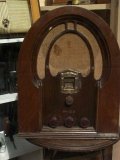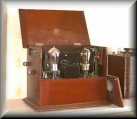PROBLEMS - LOGIC PROBLEMS - ATTRACTING THE WRONG ATTENTION - SLOPPY MIX
PRE-PRODUCTION - PRODUCTION - POSTPRODUCTION

| A mistake jars the listeners out of a commitment to the fiction world of the play. It's a battle for you to reestablish trust again. The listeners have been betrayed. The listeners will use the 'off' button. |
| In radio, only your failures attract attention. |
|
ATMOS - AVOID LOGIC PROBLEMS - the listeners sense something is wrong |
| Wrongly matched ATMOS (background or bed for the dialogue) |
|
NEUTRAL ATMOS - where it is not appropriate to the script. The choice of a NEUTRAL ATMOS does not support the sound picture you should create. SOLUTION: Go to your collection of ATMOS - SOUND BOX - production sound effects archive. Use 'open country', 'street with traffic' etc. Take the trouble to create the 'mise-en-scène' - representation of the play scene, locations, spaces and perspectives. Don't accept NEUTRAL ATMOS where 'room atmos' (room tone) is what is needed. |
|
ATMOS wrongly balanced against the dialogue |
| It is difficult to balance the DIALOGUE against the ATMOS bed ('open country', 'street with traffic' etc). You may not achieve the best balance in your first attempt. |
| ATMOS under DIALOGUE: establish at top - bring down under dialogue - nudge up occasionally |
 |
|
Poorly chosen ATMOS with peaky sound events. These fight against the dialogue. |
| Noise - beware of too much 'glare' in the sound picture! |
|
Wrong FXs, as birds out of season (migratory birds in an English winter), day birds in a night scene, today's guns or motor cars in a classic play. |
| WRONG PERSPECTIVE: Technically poor organising of the sound events, characters in the sound picture. A sloppy mix. |
|
MOVEMENT -LOGIC PROBLEMS: Character who enters in one particular door to the right of the sound picture, and who exits what is meant to be the same door, but (illogically) to the left. |
| LAZINESS: Unorganised and unfocused 'mise-en-scène'. Sound centre not clearly established. Signposting and other FXs missing. |
| DISTURBED LISTENERS (UNCONSCIOUSLY AND THEN CONSCIOUSLY): Beneath the surface of the dialogue, there are problems. |
| WHAT TO DO: Support the dialogue. The atmos, FXs and 'mise-en-scène' help the dialogue discover itself. All in a particular scene takes place in the same place, at the same time. |
| DIFFERENT SECTIONS OF THE SCENE (SEQUENCES) from PRODUCTION are organised together smoothly. |
| DIALOGUE: Removal of - poorly articulated words, unseemly actors' noises (clacking of dry lips, belly rumbles, script rustle, even denture clatter, wrong clothes movement), gaps, slow cue-uptaking (actor is slow coming in on cue). |
| DIALOGUE: Searching through alternative takes for patches (problem-solving). |
|
|



